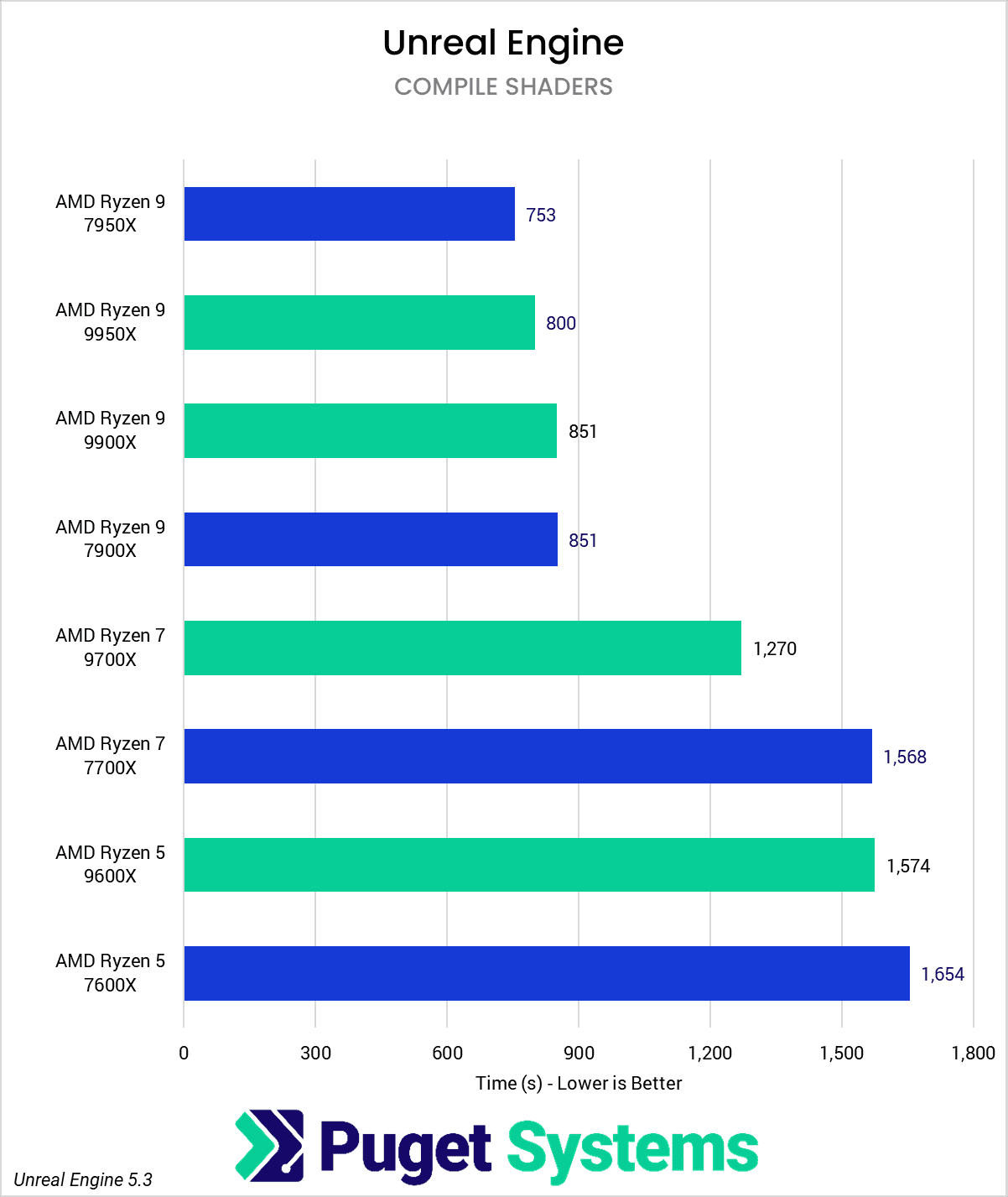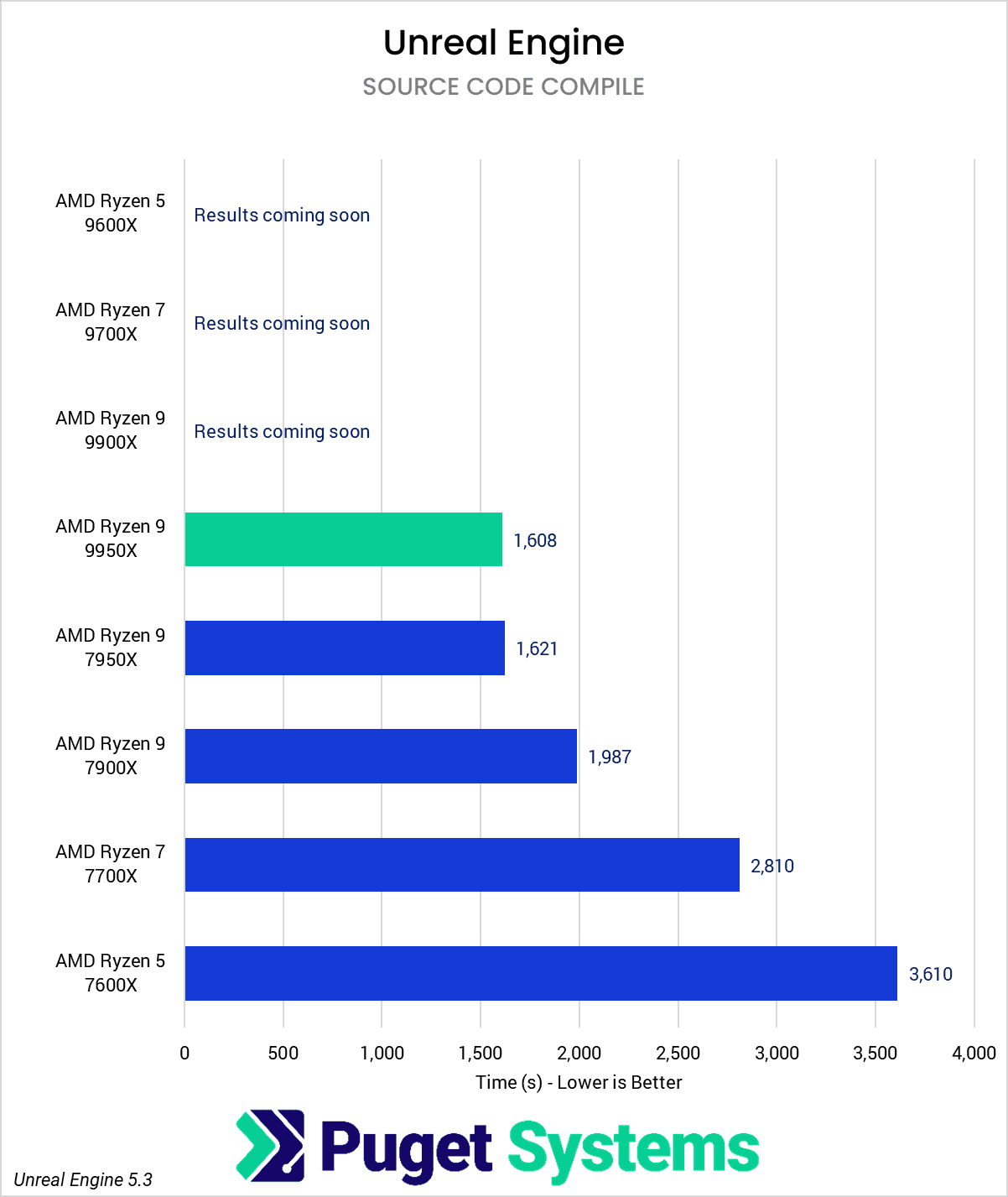Table of Contents
TL;DR: AMD Ryzen 9000 Series Processor Performance in Unreal Engine
More data is coming before we have the full picture; however, for Unreal Engine users, the new Ryzen 9000 series do not provide much more performance than their 7000 series counterparts. The biggest difference is that the lower-end CPUs are able to deliver the same performance at lower power draws. This means it is not something that we would recommend upgrading to if you currently have a 7000 series CPU. If you are on an older platform, then either option would be good depending on the price available at that time.
Introduction
The new Ryzen 9000 Series from AMD are now available, offering a mild refresh of the Ryzen 7000 processors. These processors stick with the AM5 socket and X670 motherboard compatibility while incorporating AMD’s Zen 5 CPU architecture, which delivers improved IPC (Instructions Per Clock), greater efficiency, and better memory support.
In this article, we will examine how these new processors perform specifically in Unreal Engine. We typically look at three specific tasks, Compiling Source Code, which only affects game developers, Compiling Shaders, and Building Lighting. However, due to some difficulties with both software and hardware, this article should be considered a work in progress and will be updated in the future. We had to downgrade to Unreal 5.3 because the shader compile test broke, likely due to changes in how the shader system works in 5.4. We also had issues with the 9000 series CPUs while compiling source code and are waiting for replacements before we can complete that testing.
Because we will be examining so many CPUs, we will divide our analysis into Intel vs. AMD and performance versus the previous generation.

If you want to read more about the new AMD Ryzen 9000 CPUs and what separates them from the previous generation, we recommend checking out our main AMD Ryzen 9000 Series Content Creation Review article. That post includes more detailed information on the CPU specifications, MSRP, and an overview of testing results for a range of other applications, including Photoshop, Premiere Pro, DaVinci Resolve, After Effects, CPU rendering, and Reality Capture.
AMD Ryzen 9000 vs Intel Core 14th Gen for Unreal Engine
Comparing Intel and AMD CPU models directly is a bit tough since they do not carry matching MSRP. However, the closest matches are:
- AMD Ryzen 9 9950X ($650) vs. Intel Core i9 14900K ($590)
- AMD Ryzen 9 9900X ($500) vs. Intel Core i9 14900K ($590)
- AMD Ryzen 7 9700X ($360) vs. Intel Core i7 14700K ($410)
- AMD Ryzen 5 9600X ($280) vs. Intel Core i5 14600K ($320)
In these comparisons, AMD is always a bit less expensive than Intel (other than the 9950X vs 14900K). They also have a lower power draw, meaning less heat output and noise. Because of that, if things are close, that can give AMD the advantage.
Starting at the bottom of the stack, the AMD Ryzen 5 9600X is about 25% slower than the Intel Core i5 14600K in compiling shaders. Unfortunately, the 14600K errored out on building lighting, and the 9600X doesn’t have a code compile score yet, making a wholistic comparison between these CPUs difficult. Similarly, the 9700X is around 30% slower than the 14700K in compiling shaders and roughly 20% in building lighting. That said, these are not CPUs that many people would choose for either of those tasks. Light baking could be done on the GPU, and not many people would often be compiling the source code on this class of hardware.
Moving up to the Ryzen 9 models, the 9900X performed only 5% slower than the Intel Core i9 14900K in compiling shaders and 30% faster while building lighting. This gives AMD the overall lead here due to its lower price and TDP.
At the top end, the Ryzen 9 9950X is tied with the 14900K for shader compiling, and about 30% faster in building lighting. The 9950X is the one new Ryzen that we have source code compile results for, and it is about 5% faster than the 14900K. This actually makes it a tough recommendation at the moment because Intel is offering roughly the same performance at a lower price. The price difference isn’t much, so when shopping around compare the full system price when making a final decision.
AMD Ryzen 9000 vs AMD Ryzen 7000 for Unreal Engine
When comparing the new AMD Ryzen 9000 Series to the previous Ryzen 7000 Series, you need to be aware that AMD technically introduced a small price drop with the new CPUs. However, since AMD CPUs are often on sale, in most cases, the new models will actually be a bit more expensive. That will likely even out over time, but for now, Ryzen 9000 will likely have a small price premium over the older 7000 models.
Again, starting at the lower end, the Ryzen 5 9600X sees only a 5% performance uplift in compiling shaders. The Ryzen 7 9700X posts a nearly 20% performance uplift the same task, but this is the only place we see this sort of gain in any of the 9000 series CPUs. The Ryzen 9 9900X, on the other hand, saw no difference in shader performance compared to the Ryzen 9 7900X, but did have 10% faster light bake times.
Finally, the Ryzen 9 9950X had a slightly slower performance in shaders than the 7950X, 7% faster light baking, and virtually no difference in code comping in Visual Studio. For Unreal users, there really is no improvement over the 7950X
How Well Do the AMD Ryzen 9000 CPUs Perform in Unreal Engine?
As stated, we will update some missing numbers once we have them. However, for Unreal Engine users, the new Ryzen 9000 series CPUs do not provide much more performance than their 7000 series counterparts. The biggest difference is that the lower-end CPUs are able to deliver the same performance and have lower power draws. This means it is not something that we would recommend upgrading to if you currently have a 7000 series CPU. If you are on an older platform, then either option would be good, depending on the price available at that time.
We will note again that we do not have full results for all the CPUs we tested, due to a combination of hardware and software difficulties. We plan to update this article in the near future when we can get those results, but we currently do not have a firm ETA for when that will be.
Every application uniquely utilizes hardware, so our results here don’t necessarily translate to any other application. Our focus in this article centers specifically on AMD Ryzen 9000 Series performance in Adobe Photoshop. However, we recommend checking out our AMD Ryzen 9000 Series Content Creation Review article, which includes a broad overview of results for several different applications. If you use other software packages, it also has links to our in-depth testing articles for content creation: Premiere Pro, DaVinci Resolve, After Effects, CPU rendering, and Reality Capture.
Finding the perfect workstation doesn’t have to be complicated. Explore our solutions page for a curated selection of recommended systems for a multitude of applications and workflows, or visit our custom configuration page if you already know the ideal hardware for your needs. If you need assistance with tailoring a system to a unique workflow or have any other questions, we encourage you to reach out to our dedicated technology consultants.













